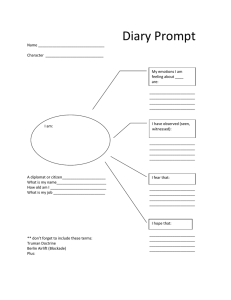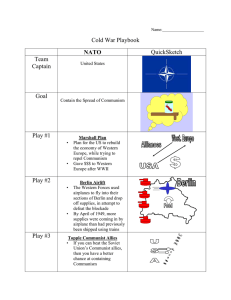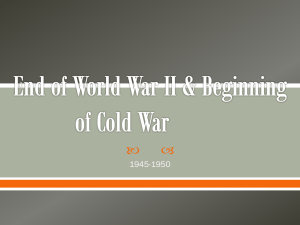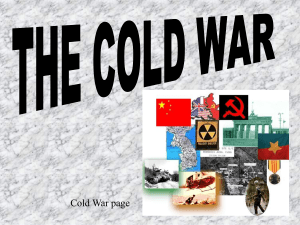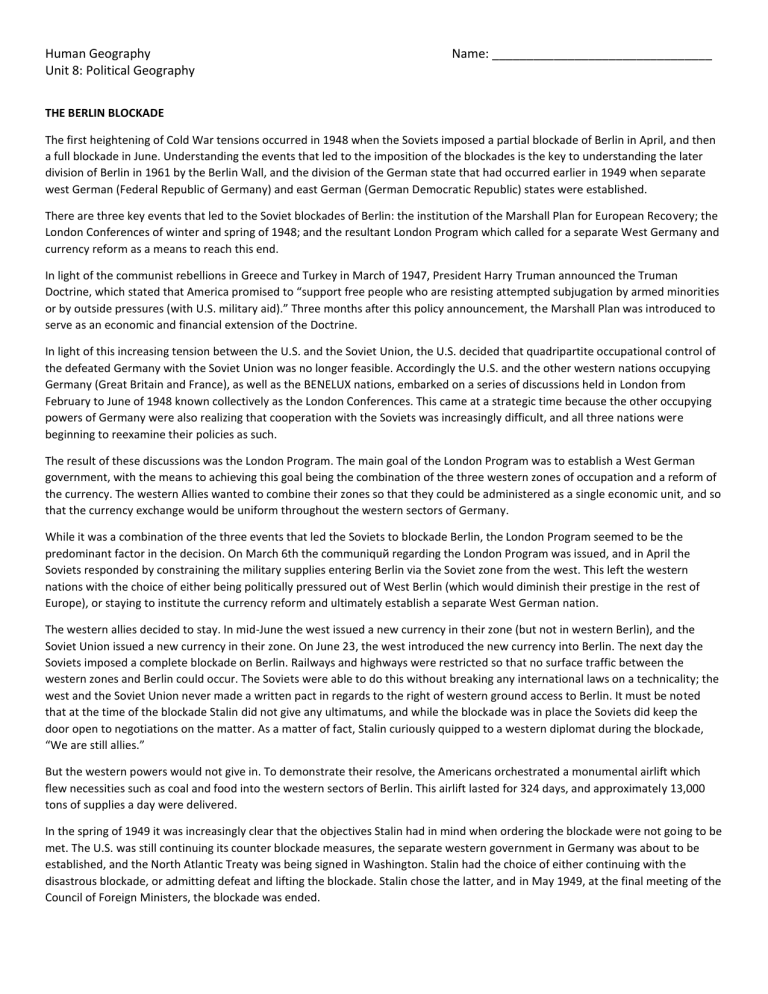
Human Geography Unit 8: Political Geography Name: ________________________________ THE BERLIN BLOCKADE The first heightening of Cold War tensions occurred in 1948 when the Soviets imposed a partial blockade of Berlin in April, and then a full blockade in June. Understanding the events that led to the imposition of the blockades is the key to understanding the later division of Berlin in 1961 by the Berlin Wall, and the division of the German state that had occurred earlier in 1949 when separate west German (Federal Republic of Germany) and east German (German Democratic Republic) states were established. There are three key events that led to the Soviet blockades of Berlin: the institution of the Marshall Plan for European Recovery; the London Conferences of winter and spring of 1948; and the resultant London Program which called for a separate West Germany and currency reform as a means to reach this end. In light of the communist rebellions in Greece and Turkey in March of 1947, President Harry Truman announced the Truman Doctrine, which stated that America promised to “support free people who are resisting attempted subjugation by armed minorities or by outside pressures (with U.S. military aid).” Three months after this policy announcement, the Marshall Plan was introduced to serve as an economic and financial extension of the Doctrine. In light of this increasing tension between the U.S. and the Soviet Union, the U.S. decided that quadripartite occupational control of the defeated Germany with the Soviet Union was no longer feasible. Accordingly the U.S. and the other western nations occupying Germany (Great Britain and France), as well as the BENELUX nations, embarked on a series of discussions held in London from February to June of 1948 known collectively as the London Conferences. This came at a strategic time because the other occupying powers of Germany were also realizing that cooperation with the Soviets was increasingly difficult, and all three nations were beginning to reexamine their policies as such. The result of these discussions was the London Program. The main goal of the London Program was to establish a West German government, with the means to achieving this goal being the combination of the three western zones of occupation and a reform of the currency. The western Allies wanted to combine their zones so that they could be administered as a single economic unit, and so that the currency exchange would be uniform throughout the western sectors of Germany. While it was a combination of the three events that led the Soviets to blockade Berlin, the London Program seemed to be the predominant factor in the decision. On March 6th the communiquй regarding the London Program was issued, and in April the Soviets responded by constraining the military supplies entering Berlin via the Soviet zone from the west. This left the western nations with the choice of either being politically pressured out of West Berlin (which would diminish their prestige in the rest of Europe), or staying to institute the currency reform and ultimately establish a separate West German nation. The western allies decided to stay. In mid-June the west issued a new currency in their zone (but not in western Berlin), and the Soviet Union issued a new currency in their zone. On June 23, the west introduced the new currency into Berlin. The next day the Soviets imposed a complete blockade on Berlin. Railways and highways were restricted so that no surface traffic between the western zones and Berlin could occur. The Soviets were able to do this without breaking any international laws on a technicality; the west and the Soviet Union never made a written pact in regards to the right of western ground access to Berlin. It must be noted that at the time of the blockade Stalin did not give any ultimatums, and while the blockade was in place the Soviets did keep the door open to negotiations on the matter. As a matter of fact, Stalin curiously quipped to a western diplomat during the blockade, “We are still allies.” But the western powers would not give in. To demonstrate their resolve, the Americans orchestrated a monumental airlift which flew necessities such as coal and food into the western sectors of Berlin. This airlift lasted for 324 days, and approximately 13,000 tons of supplies a day were delivered. In the spring of 1949 it was increasingly clear that the objectives Stalin had in mind when ordering the blockade were not going to be met. The U.S. was still continuing its counter blockade measures, the separate western government in Germany was about to be established, and the North Atlantic Treaty was being signed in Washington. Stalin had the choice of either continuing with the disastrous blockade, or admitting defeat and lifting the blockade. Stalin chose the latter, and in May 1949, at the final meeting of the Council of Foreign Ministers, the blockade was ended. 1. What are the three key events that led to the Soviet blockades of Berlin? a. _____________________________________________________________________________________ b. _____________________________________________________________________________________ c. _____________________________________________________________________________________ 2. What was the Truman Doctrine? _________________________________________________________________ ___________________________________________________________________________________________ 3. What was the goal of the London Program? ________________________________________________________ ___________________________________________________________________________________________ 4. How did the Soviets respond to the London Program? _______________________________________________ ___________________________________________________________________________________________ ___________________________________________________________________________________________ 5. What two choices did the Western nations have after the Soviets constrained their military supplies entering Berlin? _____________________________________________________________________________________ ___________________________________________________________________________________________ 6. Why were the Soviets able to impose a complete blockade on Berlin? __________________________________ ___________________________________________________________________________________________ ___________________________________________________________________________________________ 7. How did the Americans respond to the complete blockade? __________________________________________ ___________________________________________________________________________________________ ___________________________________________________________________________________________ 8. How many days did the airlift last for? ___________________________________________________________ 9. How many tons of supplies were delivered per day? _______________________________________________ 10. How did the blockade end? ____________________________________________________________________ ___________________________________________________________________________________________ ___________________________________________________________________________________________ ___________________________________________________________________________________________
